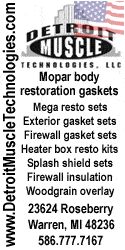Problem: When car has been warmed up for a while and driven for 1hr plus, I get a hard jerking/lurching between 1200-1300rpm when coasting down (no braking or accel). The jerking stops when rpm drops to around 1100, and disappears if I accelerate or brake.
disappears if I accelerate or brake.
Com'on guys;
I'm no genius but Ben says
"the problem disappears when I accelerate or brake."
I don't know how you come up with some of the ideas you do.
Clearly this has something to do with coasting down, which is a closed-throttle situation. In this situation, enertia is driving the engine against compression braking. So the engine is pulling very hard on the "closed" throttle blades.
Ben, if you were to shut off the engine at this time, having EFI, no more fuel could find it's way into the engine. If the lurching stops, badaboom, it proves my Transferslot/ hot plug theory.
With EFI the solution is a lil different.
If you have an AIS motor, I would work on the synchronization between that and the closed throttle stopper, together with the fueling. 1100rpm is what roadspeed? 25/28 mph? And you are slowing from hiway speed right? By this time, if you have the right speed-O gear for the rear end, the trans, if it had an automatic lock-up TC, it should have outshifted a long-time ago; unless your Line-Pressure has been boosted by way too much Throttle Pressure via the KD linkage.
Since you say the problem goes away with application of throttle this pretty much absolves the trans of any wrong-doing. Since you say the problem goes away with the application of the brakes this also rules the trans out.
But it simultaneously also proves the brakes have nothing to do with this problem. And to top it off it rules out the rear end.
IMO this is 100% an AFR problem; the engine is either misfiring in this circumstance or the mixture is pre-igniting, fired by something hot in the chamber. And, because of what preceded it, namely the long cruise period; if it was a carb I would be blaming it on hot plugs.
But since it is EFI, it could be your O2 sensor is giving the wrong feedback to the computer on account of the 230* cam. If you can turn it off during deceleration, that is the first thing I would try. Ok no, second thing. The first thing I would do is prove that the headers are sealed to the heads, and to the exhaust pipes, and that the exhaust valves are sealing. That cam has a lot of overlap, I mean a lot! I'll guess close to 70*.
During closed throttle, the pistons are gonna put a heavy pull on the plenum.
During the overlap phase, BOTH valves of every cylinder are gonna be open, each pair in turn, and the headers are ALSO gonna pull on the intake.
So; if there is fuel in the plenum, the headers are gonna yank it out and pull it down to the O2 sensor, and the O2 will do it's job and tell the computer that something is waaaay messed up, and the computer will try to lean the mixture out, cuz at the high manifold vacuum, the programming should have been set quite lean.
However;
If your headers are pulling in air from another source, like the flanges, then the O2 could be reading who knows what.
Therefore, I say; prove the headers then put the ECU into open-loop during decel; see what happens.
















